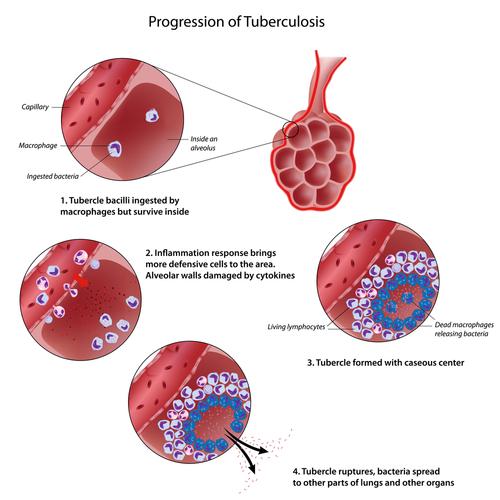Tuberculosis
Definition of Tuberculosis
Tuberculosis is a common, fatal and infectious disease. It is usually caused by strains of Mycobacteria, normally Mycobacterium tuberculosis. It usually attacks the lungs but can also affect other parts of body. It spreads when someone suffering from TB coughs or sneezes or transmits respiratory fluids through air. A type called Latent Tuberculosis doesn’t have symptoms.
Cause of Tuberculosis
Tuberculosis is caused by bacteria that spread from person to person. They spread by means of microscopic droplets in air. The causes for this droplet formation are as follows.
-
When a person:
-
Sneezes
-
Coughs
-
Speaks
-
Spits
-
Laughs
-
Sighs
-
-
People who have treatment of TB for two weeks are not contagious. Two main causes for TB are as follows.
-
HIV and TB:
-
One of the main causes for TB is HIV. HIV decreases body’s immune system making it difficult for body to control TB bacteria. This is why HIV patients are more likely to get TB.
-
Drug resistant TB:
One of the main causes for TB is the increase in drug resistant strains of bacterium.
Signs and Symptoms of Tuberculosis
Tuberculosis can infect any part of the body but it normally affects lungs and is called Pulmonary Tuberculosis. When tuberculosis occurs outside lungs it is called extra-pulmonary Tuberculosis. General symptoms for tuberculosis are as follows.
-
Fever

-
Chills
-
Night sweats
-
Appetite loss
-
Weight loss
-
Muscle fatigue
-
Finger clubbing
-
Coughing lasting for three or more weeks
-
Coughing up blood
-
Chest pain
Risk Factors for Tuberculosis
Following are the risk factors for Tuberculosis.
-
People with weakened immune systems are more at risk to develop Tuberculosis. Some of the diseases that affect immune system are as follows.
-
HIV/AIDS
-
Diabetes
-
Certain cancers
-
-
People who travel in countries that have high Tuberculosis rates are more at risk. Some of these countries are as follows.
-
Sub-Saharan Africa
-
India
-
China
-
Mexico
-
Parts of former Soviet Union
-
-
Long term alcohol and drug use weakens immune system thus putting you at risk for developing tuberculosis.
-
Use of tobacco is one of the major risk factors.
-
Contact with people who are ill increase the risk for exposure to TB bacteria.
Diagnosis of Tuberculosis
Diagnosis begins with history and physical examination. Doctor checks lymph nodes and listens to sounds of lungs when patient breathes with the aid of stethoscope. One of the common diagnostic approaches for tuberculosis includes simple skin test. A substance called PPD Tuberculin is injected just below the skin inside forearm. Within 48 to 72 hours there is a swelling at injection site. A hard raised red bump shows that patient is suffering with Tuberculosis. However this test is not perfect.. Some of the tests for diagnosing tuberculosis are as follows.
Blood Tests:
Blood tests are carried out to rule out latent or active tuberculosis. They are performed to check immune system’s reaction against TB bacteria.
Chest X-ray:
In case of a positive skin test doctor usually orders a chest x-ray. This x-ray shows white spots in lungs where immune system has walled off TB bacteria.
Sputum tests:
In results of Chest X-ray doctor further performs Sputum test. Samples of mucus are tested for TB bacteria. They are also tested to see if they are resistant against medications.
Prevention from Tuberculosis
Prevention of Tuberculosis depends upon the following two steps.
-
Vaccination of babies with BCG (Bacille Calmette-Guerin)
-
Detection and appropriate treatment of active case.
Treatment of Tuberculosis
Treatment of Tuberculosis is done as follows.
New onset:
The early treatment of tuberculosis includes six month combination of antibiotics. These antibiotics include the following.
-
Rifampicin
-
Isoniazid
-
Pyrazinamide
-
Ethambutol
Recurrent disease:
In the case of tuberculosis being recurrent, it is important to determine the antibiotic against which it is sensitive before concluding the treatment. If the multiple drug resistant TB is detected then a course of 18 to 24 months of four effective antibiotics is suitable.
